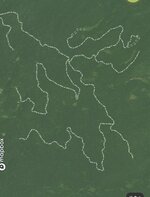HunterKyle
FNG
- Joined
- Sep 6, 2022
- Messages
- 10
Just curious about some general knowledge on onx mapping. One area I’m considering for this September has what seems to be quite a few either fire lanes or just old shut down roads and I just what to know if this is something I should definitely avoid because of the likely hood of pressure or not. the gap between definite trails that grant access is almost 4 miles
Sent from my iPhone using Tapatalk

Sent from my iPhone using Tapatalk
